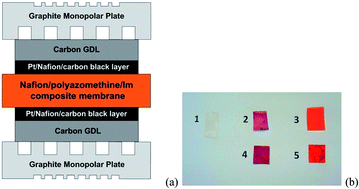Polyazomethines and their acid–base interactions with Nafion and Nafion–imidazole membranes for efficient fuel cells†
Abstract
We propose, for the first time, aromatic polyazomethines applied in polymer electrolyte membrane fuel cells (PEMFC) as tetrafluoroethylene-perfluoro-3,6-dioxa-4-methyl-7-octene-sulfonic acid copolymer (PFSA) membrane modifiers. Two types of polyazomethines were selected to impregnate pristine PFSA membranes; one with bibenzimidazole groups (25Bo-BABPI) and the second with thiophene rings (2252Th-DMB). In addition, these composite membranes were doped using imidazole (Im) to increase the proton conductivity. The success of the impregnation process of all modified membranes has been confirmed based on FTIR spectroscopy. From the water sorption analysis performed, the obtained PFSA composite membranes were found to be thermally stable (TGA, DTG results) and revealed lower dependency on water, which served as an advantage. The typical membranes used were activated in boiling deionized water, then in 3.75% H2O2, and finally in boiling 0.2 M H2SO4. Moreover, both polyazomethines were oxidized with FeCl3 to check their chemical oxidation abilities. Single PEMFCs assembled using polyazomethine composite membranes were characterized by improved performance, increase in the maximum power density by two folds, higher proton conductivity and larger electrochemical surface area of catalyst in comparison to reference samples. The maximum power density of 231 mW cm−2 at the current density of 637 mA cm−2 was detected for PFSA–25Bo-BABPI membrane. In accordance with the experiments carried out, polyazomethines have positive influence on PEMFCs' overall electrochemical properties. All membranes were tested by atomic force microscopy (AFM) and scanning electron microscopy (SEM) with EDX to analyze their morphology.



 Please wait while we load your content...
Please wait while we load your content...